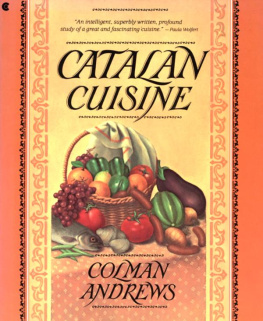CONTENTS THERE IS NO PARADISE.
GOD LIVES HERE! Barcelona, this old yet eternally young city, is one of only a few in the world that has successfully reinvented itself. The city underwent major refurbishment for the Olympic Games in 1992, when it was given a new public transport system, a new airport and even completely new suburbs. Since then, it has slowly but surely become a top destination for tourists from all over the world. And theyre right: Barcelona is definitely worth a visit, for so much more than sightseeing. Barcelona, the capital of the Spanish region of Catalonia, has always attracted lots of people. Migrants from poorer areas of Spain, including the regions of Andalusia, Extremadura and Galicia, came as early as the 19th century in search of a better life.
They brought not only their customs from their native regions but also their recipes. No need to deprive yourself! This is how Barcelonian cuisine came to incorporate many different influences: gazpacho from Andalusia, paella from Valencia, marmitako from the Basque country and many other dishes. Later, migrants from the Near, Middle and Far East, from Africa and from South and Central America brought even more colour to the culinary potpourri that is this city. Cassava, plantains, sweet potatoes, mung beans, ginger, curry and soy sauce have all become fixtures in Barcelonian cuisine, which is a true cocina de fusin . Ive never come across any other city that makes it so easy to spoil yourself with truly amazing food at such reasonable prices. The Mediterranean Sea is right at the citys doorstep, and the surrounding regions are veritable treasure troves of culinary delights.
The almost limitless selection of fish and seafood in La boquera , Barcelonas best-known market, invites you to explore the citys rich food culture. El Prat de Llobregat, the delta of the Llobregat river south-west of Barcelona, is the citys kitchen garden, where delicious calots (spring onions/scallions) and cabbages are grown in winter and fantastic artichokes and broad beans in spring. Farmers cultivate a huge variety of vegetables here throughout the year, including chickpeas, tomatoes, eggplant (aubergine) and various types of fruit. Catalans are obsessive about mushrooms and cook with vast amounts of them in autumn. This is when red pine mushrooms, chanterelles and Caesars mushrooms feature prominently on the menus of local restaurants. Traditional Spanish cuisine also uses a lot of rice, not only in the famous paella, and this is also true for Barcelona.
Luckily there is a huge rice-growing region a little further south of the city, near Tortosa in the Ebro delta. Spaniards also love pasta. Filled, large pasta tubes called canelones are a traditional Christmas dish, and escudella i carn dolla , the regions famous meat and pasta stew, is a must on major holidays. Fideos , a type of thin, short noodles, are very important, too; these are usually cooked together with seafood, mushrooms, vegetables or poultry in the same stock. Poultry is, of course, very important in traditional Catalan cooking. Chickens, ducks, quail, delectable pheasants and perdices , which are quite similar to partridges, are cooked throughout the year according to a seemingly endless variety of recipes.
Naturally, meat also plays a major role in Spanish cuisine: there is rabbit, lamb and beef (excellent beef is produced in the neighbouring region around Girona) and, above all, pork. Venison makes its way into Catalan pots and pans in autumn, and poor mans meat, that is, snails, also deserve a mention. One of the outstanding features of Catalan cuisine is dishes that fuse ingredients sourced from the sea and the land ( mar i muntanya ), in combinations that often seem almost outlandish to non-locals. There is bean soup with mussels, rabbit with prawns (shrimp) or chicken with fish and seafood, to name just a few.
Now a few words on dining culture: Spaniards have very frugal breakfasts, often consisting of no more than a cup of coffee at home. On their way to work they might then have a bocadillo , that is, a small roll, or a cruasn .
Simply try to pronounce this and yes, it is indeed a croissant! If people get hungry before lunch, they can always snack on a few tapas in the late morning, as Spaniards only have lunch from about 2 pm. In the late afternoon, they might then have a few more tapas with a vermut or a caa , that is, a draught beer. People usually do not come home from work until late, so dinner is also a late affair. Restaurants open at about 8.30 pm at the earliest, and dinner is generally quite rich, especially on weekends. The culinary highlights described below are well worth your attention during a stroll through Barcelona everything else youll find in your travel guide!

In the old quarter of El Born/La Ribera youll find some palaces that are well worth a visit, but most importantly this quarter is home to the Mercat de Santa Caterina, which was fully refurbished a few years ago and fitted with a colourful new roof. Here, youll find a number of interesting bars and restaurants, for example the Cuines Santa Caterina inside the market.
The Gothic quarter of El Raval is right next to Las Ramblas in the city centre. This is where Barcelonas high society moved to between the 17th and 19th centuries in an attempt to escape the dark and narrow lanes of the old part of the city, and this is where youll find, above all, the world-famous La boquera or Mercat de Sant Josep. Sadly, the market has been losing some of its authentic appeal due to a steady stream of tourists, and these days many stalls sell fancy colourful fruit cocktails rather than fruit and vegetables. However, if you are lucky enough to find a seat in the El Quim de la Boquera or in the Pinotxo, youll be spoiled with authentic dishes. Even Raval still has some good restaurants, for example the stunningly beautiful Fonda Espaa in the Hotel Espaa or the Ca lIsidre, a true bastion of traditional Catalan cuisine. The old, recently re-opened brewery Moritz in the quarter of Sant Antoni serves beer on tap.
The quarter of Eixample (extension), which was built as recently as the turn of the 20th century, also has a wealth of interesting restaurants, as do the quarters of Grcia, Sant Gervasi and Sarri. Ill only mention three examples: Tragaluz, Osmosis and Etapes, but there are plenty more, and shops in the little side streets sell anything and everything to do with food and cooking. If you love fish and seafood, you may want to head for the restaurants of Barceloneta, which was the fishermens quarter a long time ago. Newer quarters such as Poblenou, which was built for the Olympic Games, or 22@, also have a great restaurant culture. The latter is home to the ESHOB the Barcelona School of Culinary Arts and Gastronomy. The Catalan master chef Ferran Adri revolutionised the international culinary world with his ground-breaking creations, and his style of molecular cooking has also had a clear influence on Barcelonian cuisine.



















